Leatherback Sea Turtle
Planet: Earth
Scientific Classification
Kingdom: Animalia
Phylum: Chordata
Class: Reptilia
Order: Testudines
Family: Dermochelyidae
Genus:
Dermochelys
Species:
Dermochelys coriacea
The largest of the sea turtles and the only extant species in the Dermochelyidae family on Earth, leatherback sea turtles spent many years in the Vulnerable and Endangered categories on the IUCN Red List.
Our trio of leatherback sea turtles enjoy a 60,000 gallon enclosure all to themselves, as well as a large island for them to nest on. They are a recent addition, and we are hoping to breed a pair and hatch some eggs.
Wintry Side-Necked Turtle
Planet: Puriena
Scientific Classification
Kingdom: Animalia
Phylum: Chordata
Class: Reptilia
Order: Testudines
Family: Chelidae
Genus:
Chelus
Species:
Chelus wintaires
Wintry side-necked turtles are one of countless in the chelidae family, all somewhat resembling fallen logs and rotting corpses with their warty, wrinkled skin and scales. Wintry side-necked turtles live on Puriena, where they camouflage as snow-covered rocks on frozen swamplands.
We've set up a special challenge for our visitors, where if you spot a wintry side-necked turtle with proof you will win a wonderful prize.
Bamboo Turtle
Planet: Puriena
Scientific Classification
Kingdom: Animalia
Phylum: Chordata
Class: Reptilia
Order: Testudines
Family: Geoemydidae
Genus:
Spohieine
Species:
Spohieine bambusae
Another turtle species from Puriena, bamboo turtles are not even a centimetre in width. They hollow out marine bamboo and live inside, slowly breaking it down as they consume the bamboo from the inside out.
Our bamboo turtles live in the same bamboo they would on their native planet, only we have installed windows for people to see inside.
Bamboo turtles are very easy to take care of and the sophonts of Puriena often do, as bamboo-shaped vivariums are cheap to build and buy.
Serrated Tortoise
Planet: Aphaira
Scientific Classification
Kingdom: Animalia
Phylum: Chordata
Class: Reptilia
Order: Testudines
Family: Serataidae
Genus:
Sceratis
Species:
Sceratis gladius
One of the tortoises to call the Carnivorous Tortoises Sector home, serrated tortoises are apex predators. Defeating the slow stereotype that most tortoises know, serrated tortoises are fast-paced and will chase down their prey for as many hours as they need.
These remarkable animals get 7 acres of savannah in their enclosure shared with an array of bird species. Our pair of serrated tortoises leave them alone since they know even eating all of them will not fill them up, and it wastes too much energy.
Disc Tortoise
Moon: Titan
Scientific Classification
Kingdom: Animalia
Phylum: Chordata
Class: Reptilia
Order: Testudines
Family: Porfinidae
Genus:
Porfinis
Species:
Porfinis porfinis
From the moon Titan of planet Saturn are disc tortoises. These animals get the name from their disc-shaped shells, which come in a whole variety of colours and patterns. Disc tortoises are sometimes kept as pets by the native Titans, who love to collect the rarer disc tortoises.
In the A To Zoo we have 101 disc tortoises, some rarer and some more common. We are particularly proud of our star-sheaved morph, the only one of its kind in the Yonderverse.
Elephant Tortoise
Planet: Naurivin
Scientific Classification
Kingdom: Animalia
Phylum: Chordata
Class: Reptilia
Order: Testudines
Family: Naurividae
Genus:
Tauruisiv
Species:
Tauruisiv morelis
Elephant tortoises are named as such thanks to their long trunks extending from their heads and tails. This double-sided tortoise can breathe, eat and excrete from both ends and is both a wonder and a horror of the natural world.
Our pair of elephant tortoises make for a wonderous natural exhibit for children, learning about the truly weird and wonderful animals of our world.
Turtling
Planet: Hathuitun
Scientific Classification
Kingdom: Animalia
Phylum: Chordata
Class: Reptilia
Order: Testudines
Family: Kinosternidae
Genus:
Minikinosternus
Species:
Minikinosternus aravinii
Turtlings are the most adorable of the turtles from Hathuitun. Their entirely black shells keep them completely camouflaged in the black waters of the Abysmal Crevasse near the North Pole of their home planet.
Our turtlings live in an aquarium that mimics the Abysmal Crevasse almost perfectly. The only difference however, is that it's not the same size. See if you can spot all of our 93 turtlings in their enclosure!
Tremendously Terrifying Treetop Turtle
Planet: Xiskin
Scientific Classification
Kingdom: Animalia
Phylum: Chordata
Class: Reptilia
Order: Testudines
Family: Polemanidae
Genus:
Polemanus
Species:
Polemanus iris
There's a good reason why our TTT turtle exhibit is not walk-through - these carnivores like to drop onto their prey from above, and unfortunately most of our visitors look like tasty morsels.
Instead, you walk above their exhibit and you can get a good look at their rainbow shells if you're lucky and they're basking in the sunlight.
Onilean Tortoise
Planet: Burhn
Scientific Classification
Kingdom: Animalia
Phylum: Chordata
Class: Reptilia
Order: Testudines
Family: Testudinidae
Genus:
Aldabrachelys
Species:
Aldabrachelys onilea
Sharing a genus with only one other tortoise, onilean tortoises are named after the desert they inhabit on the planet Burhn. They are well adapted to the seering temperatures, and frequently submerge themselves underwater for days on end as soon as an oasis is in reach.
In our zoo the temperatures are not so high, but their enclosure does feature a pool if they would like to go for a swim. We believe in mimicking natural environments as much as we can.






These all sound so interesting, I especially love the predator species!
Thank you so much! :D